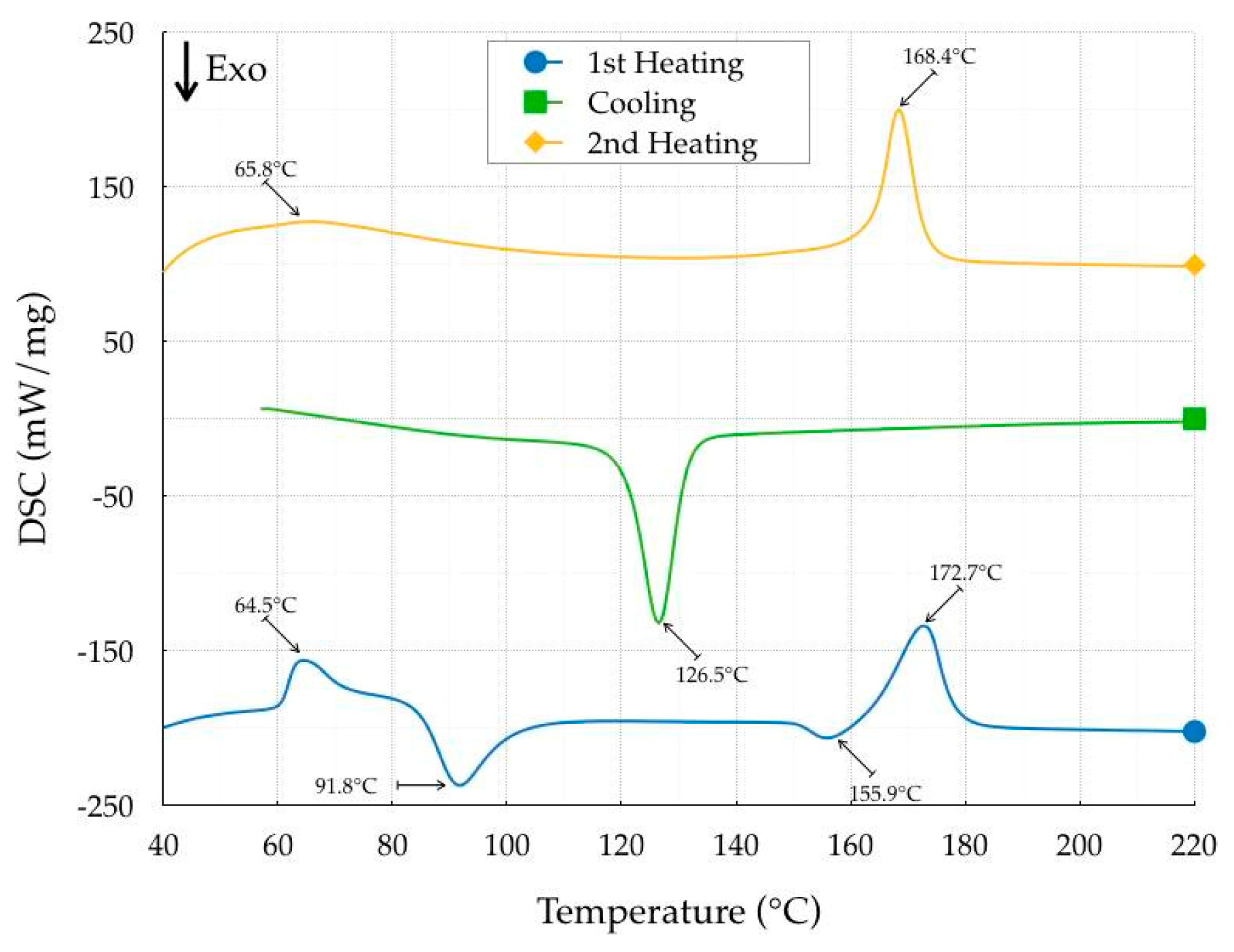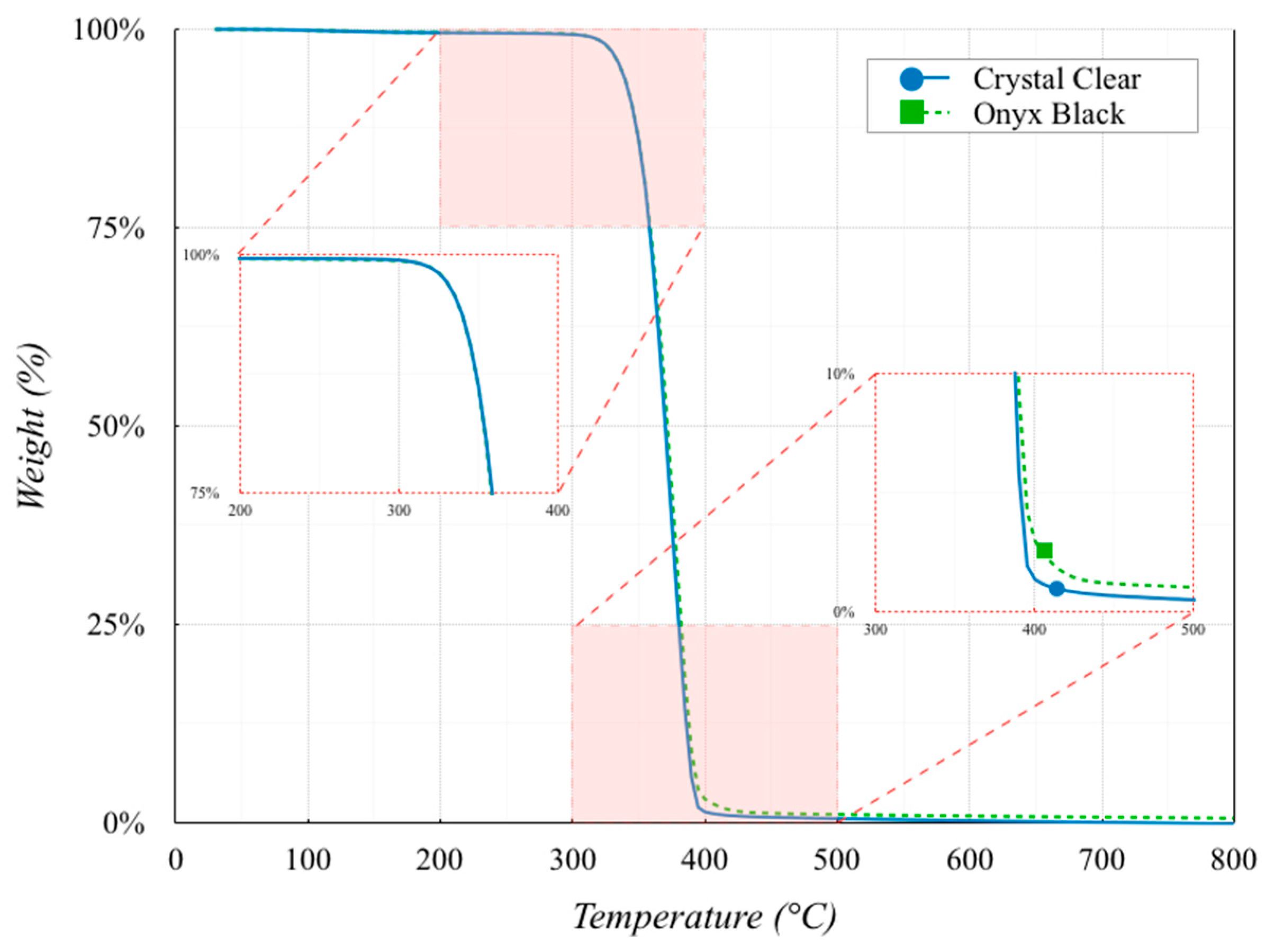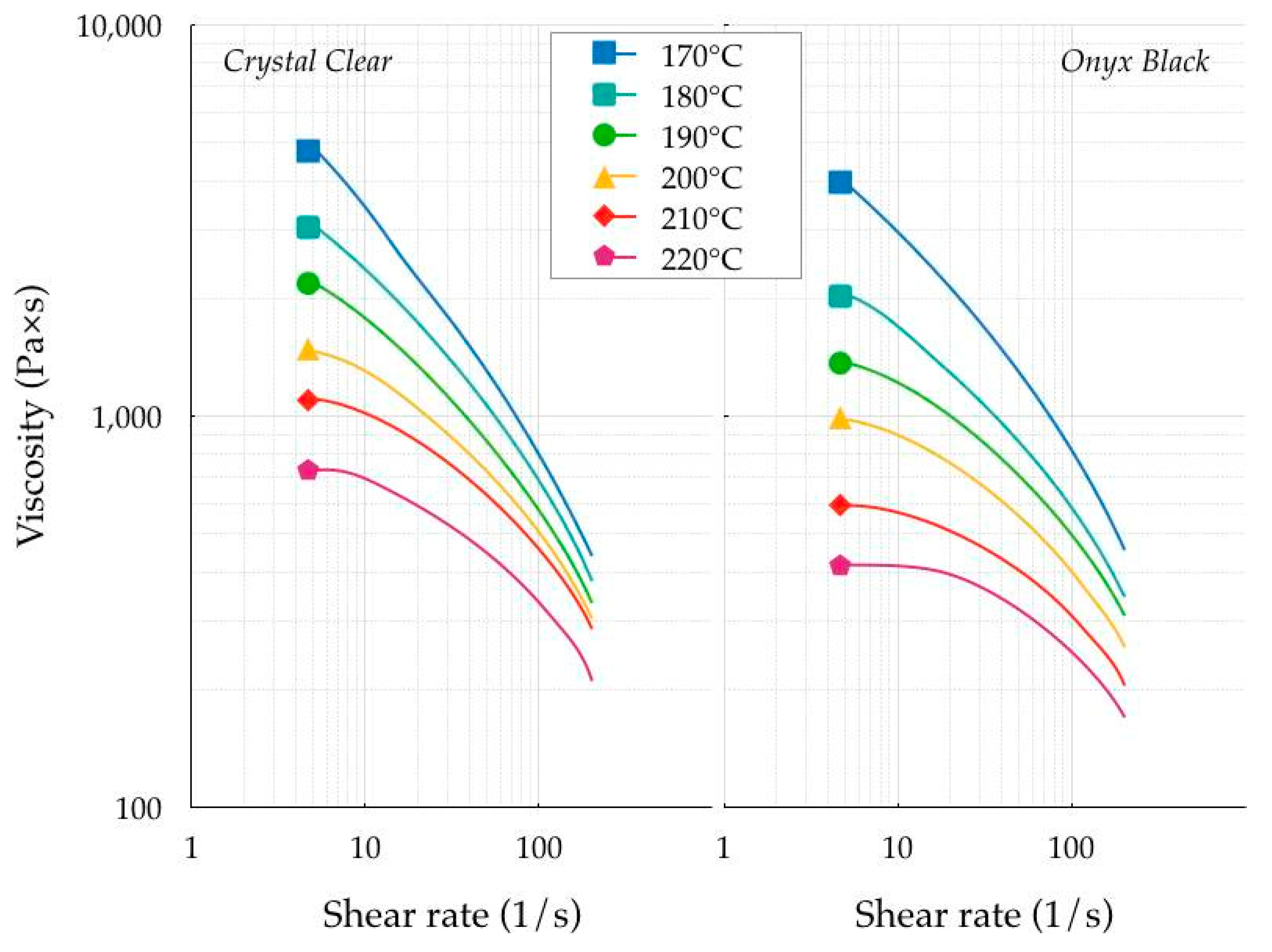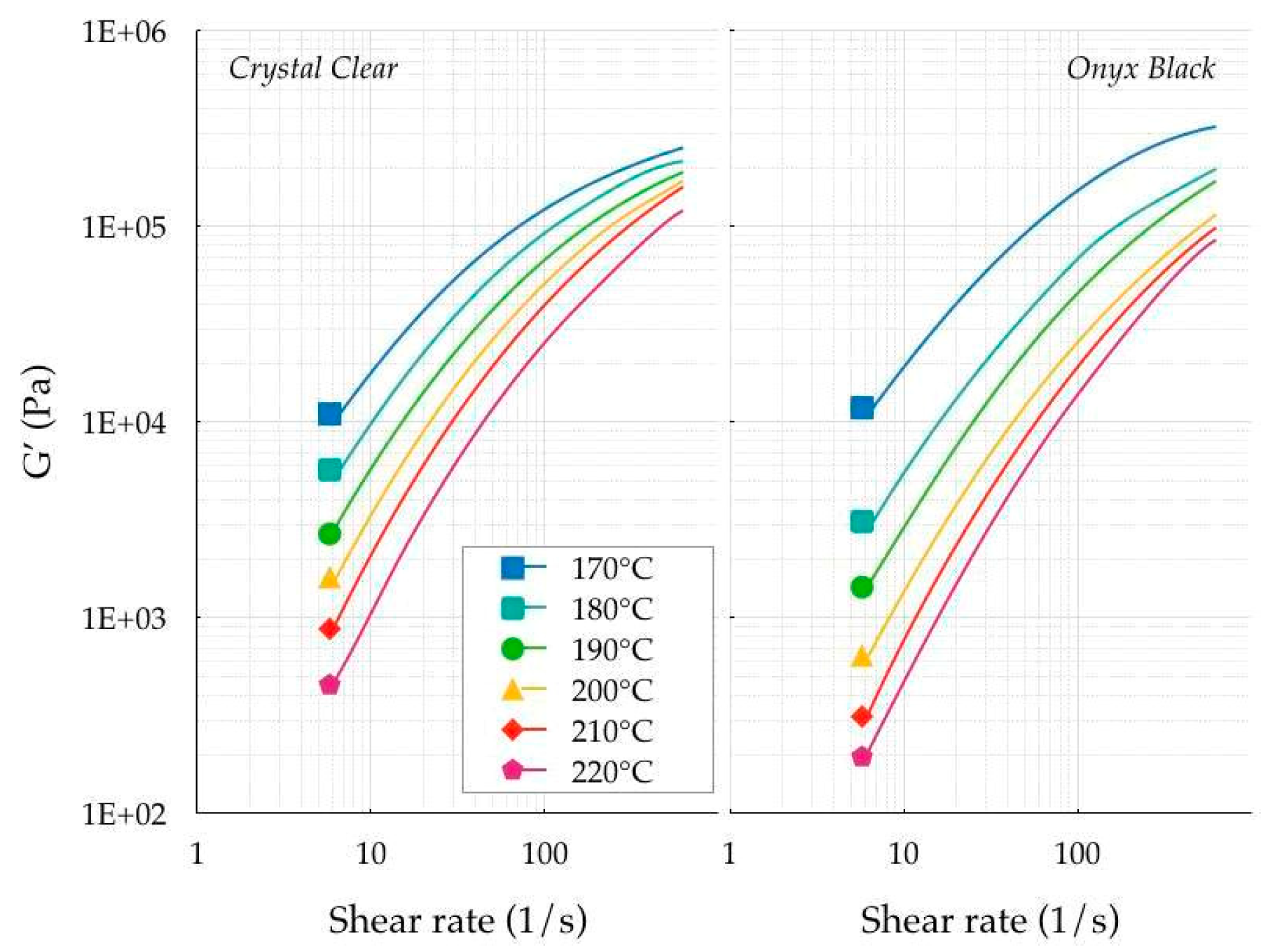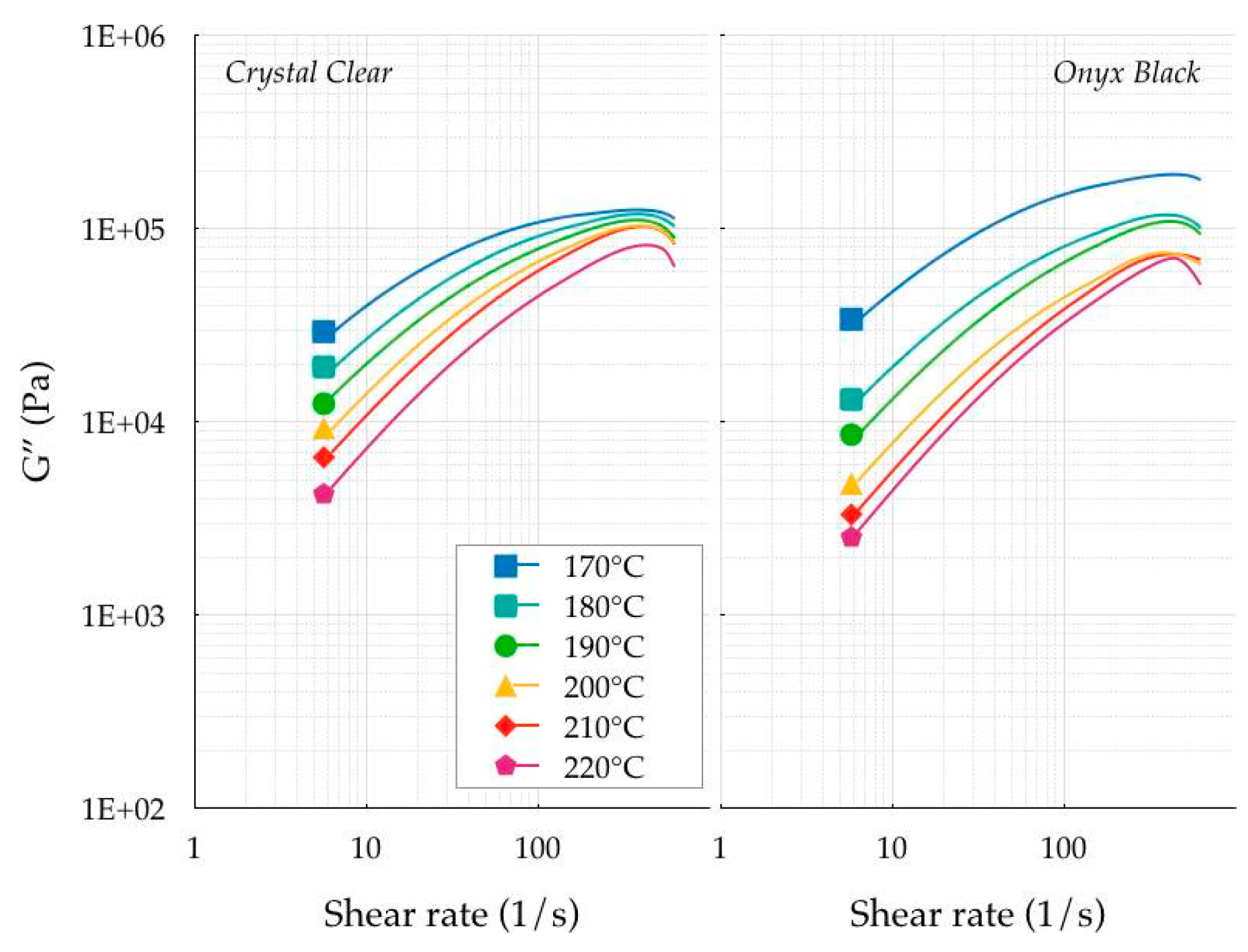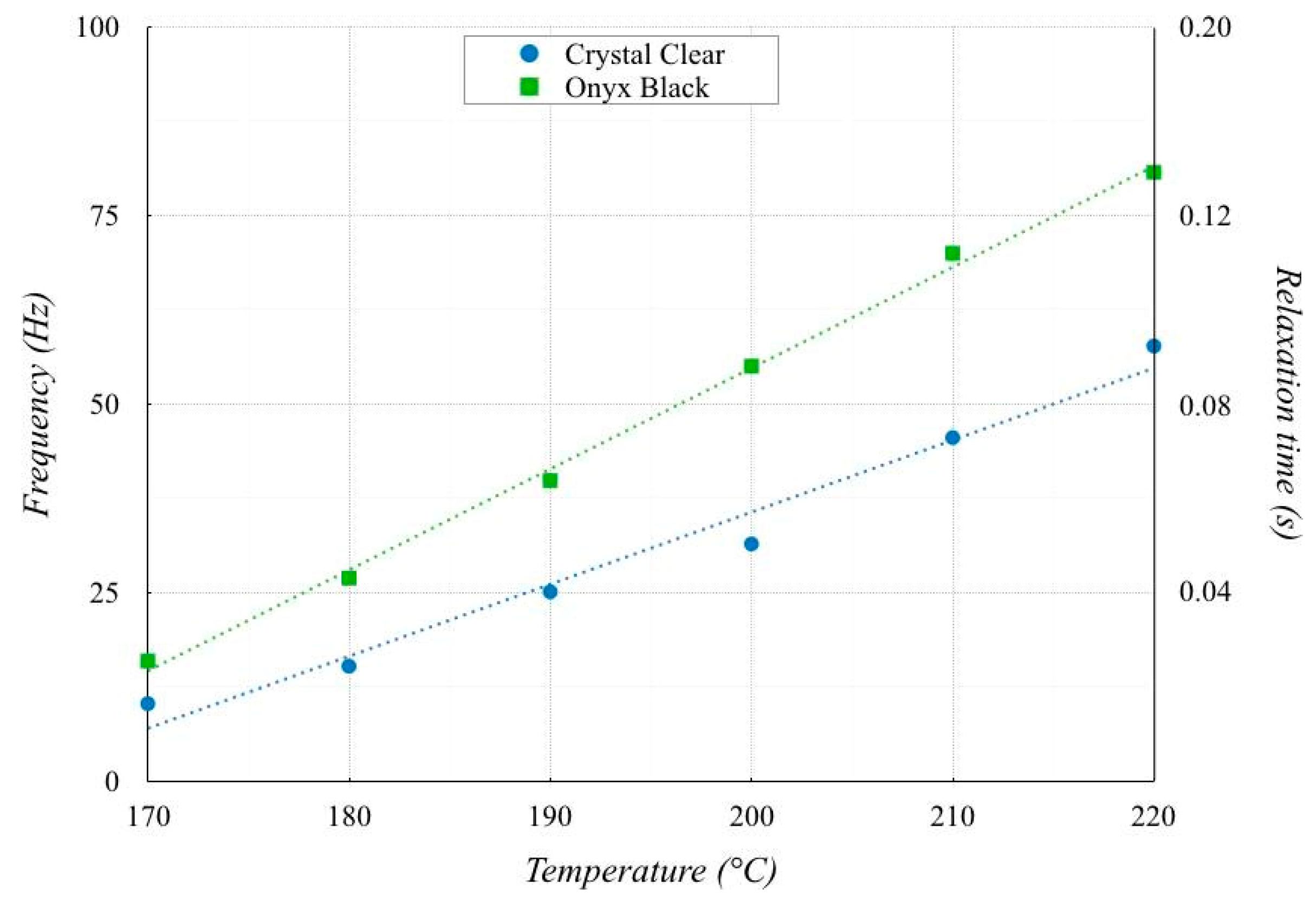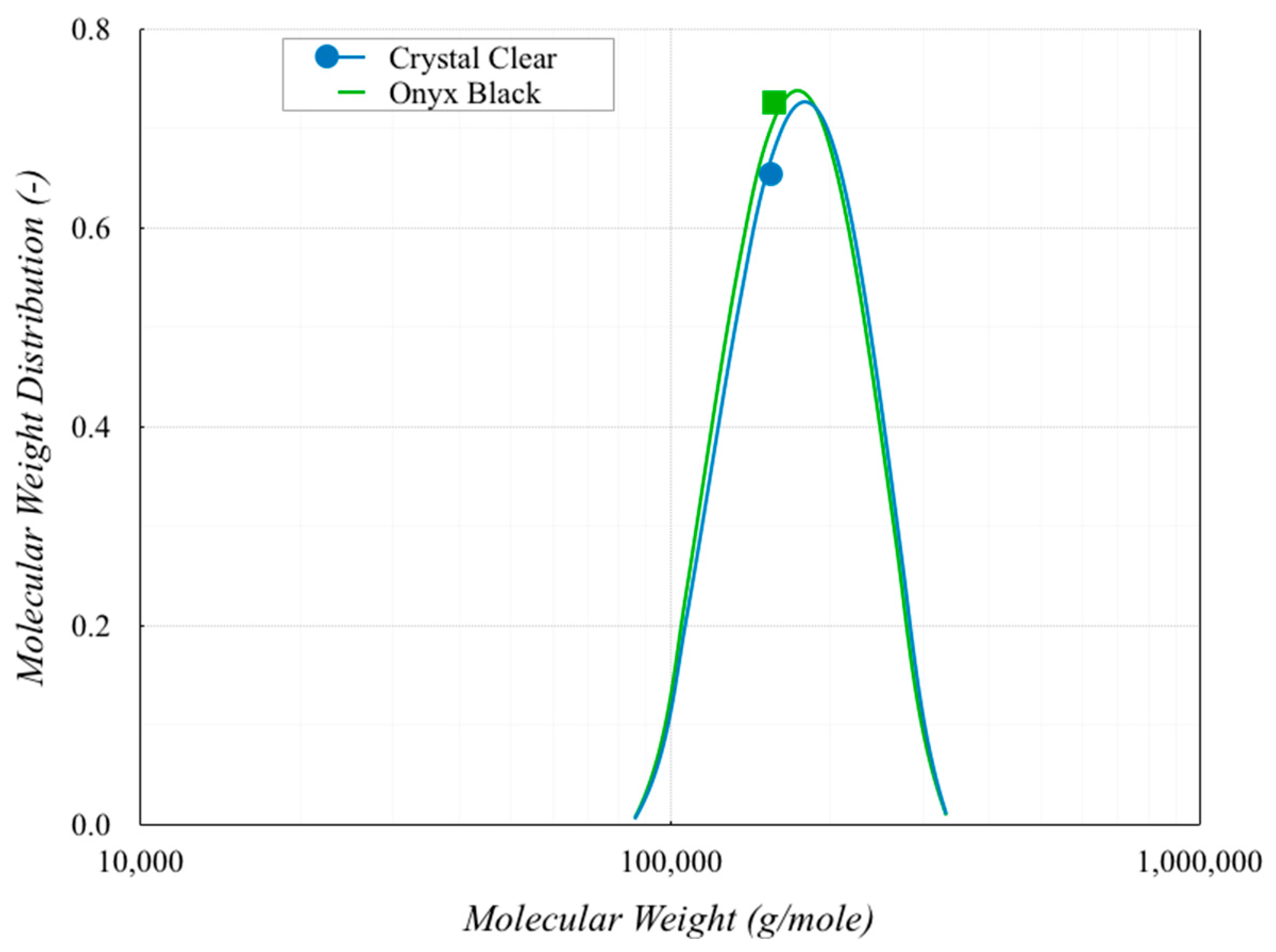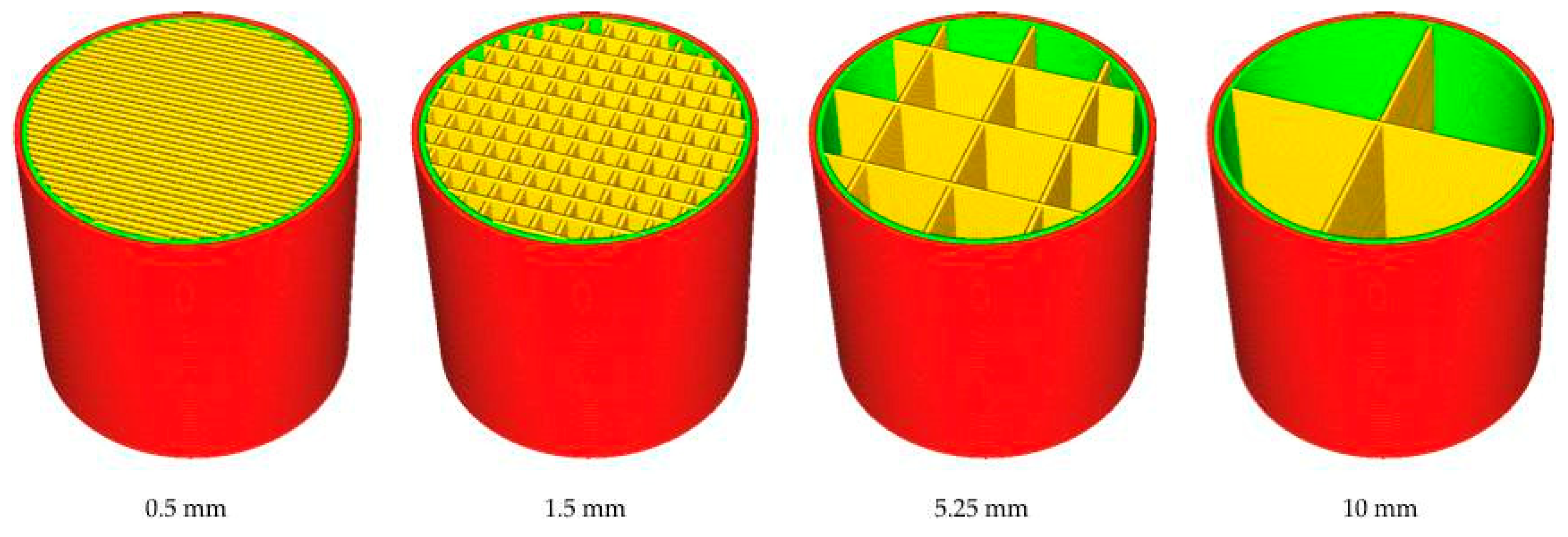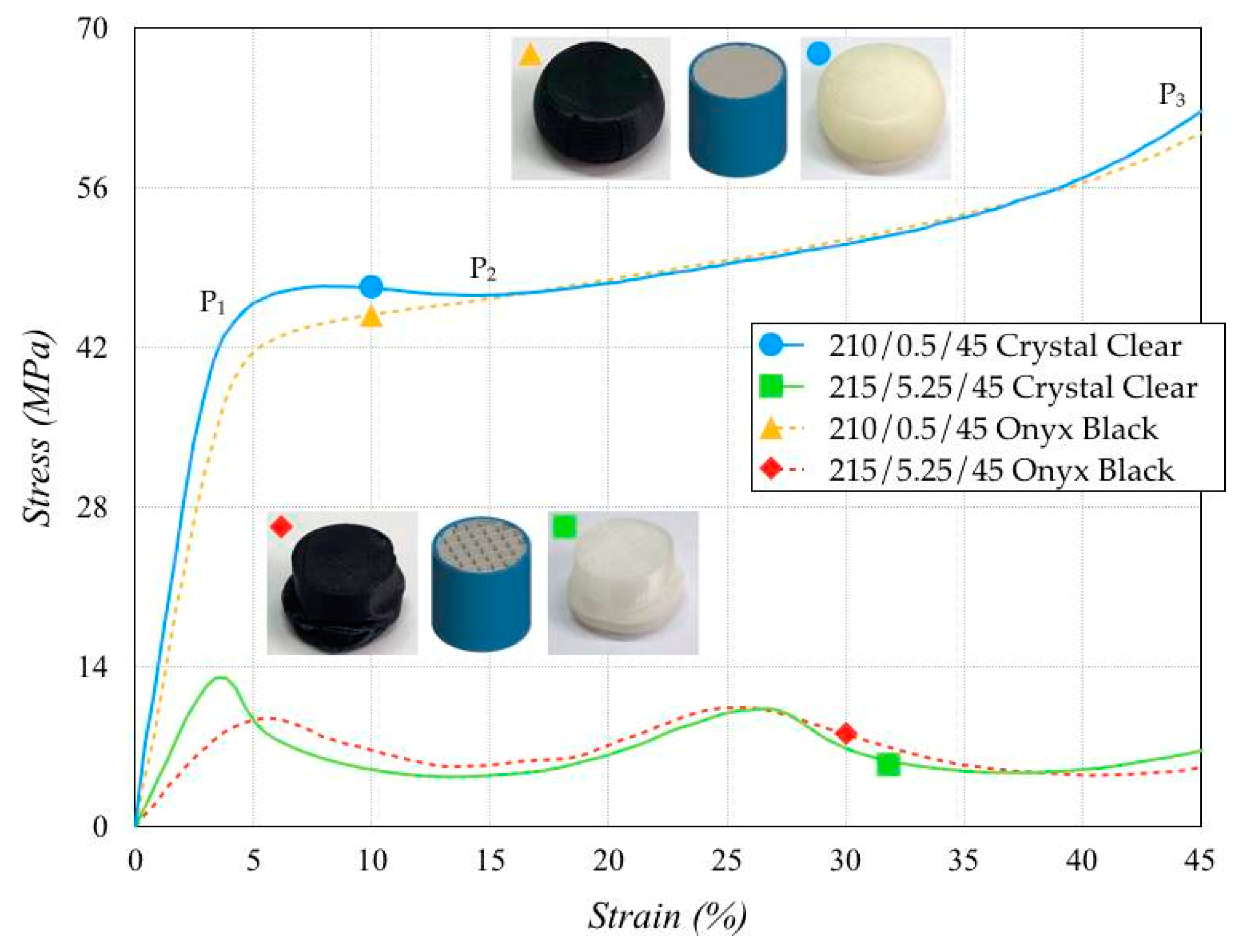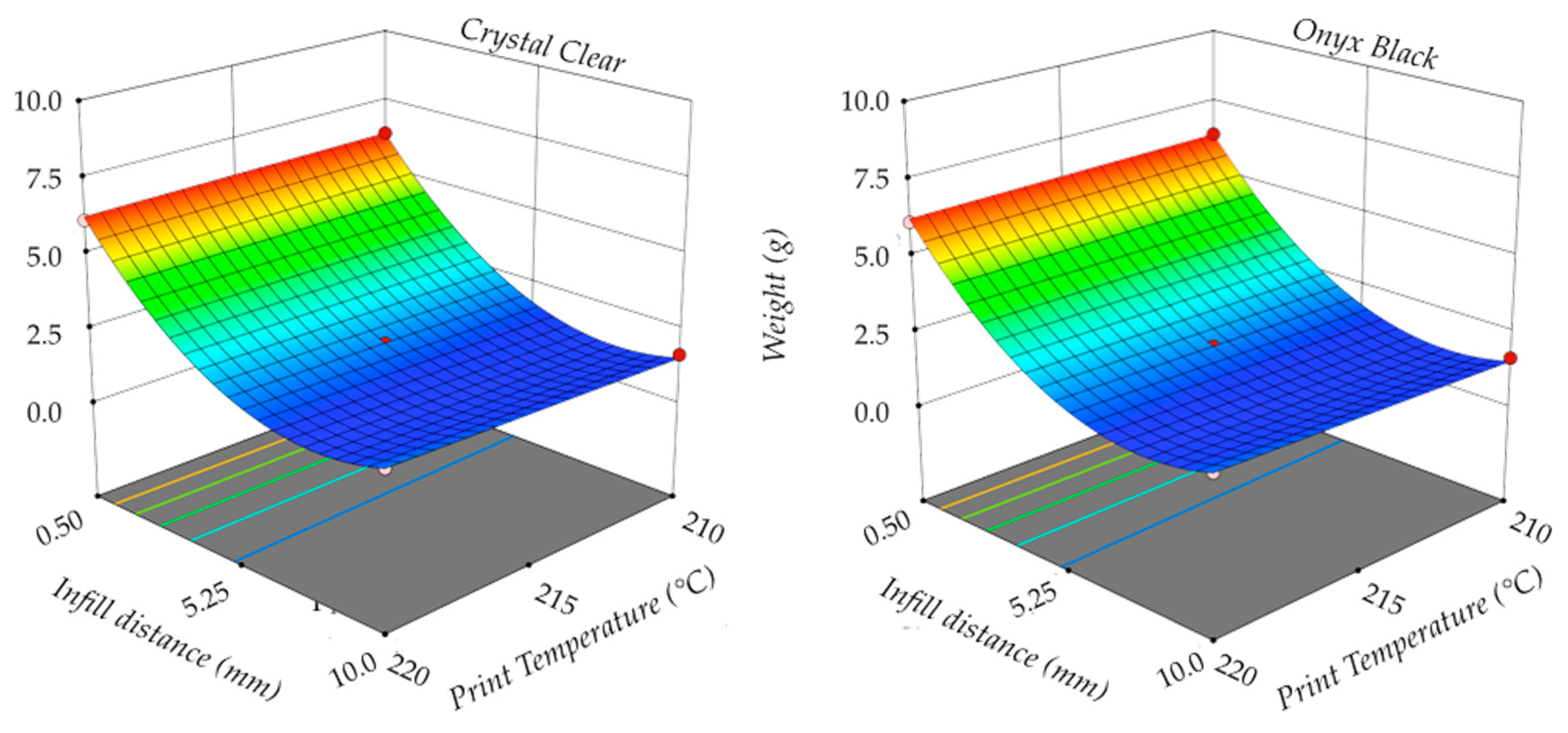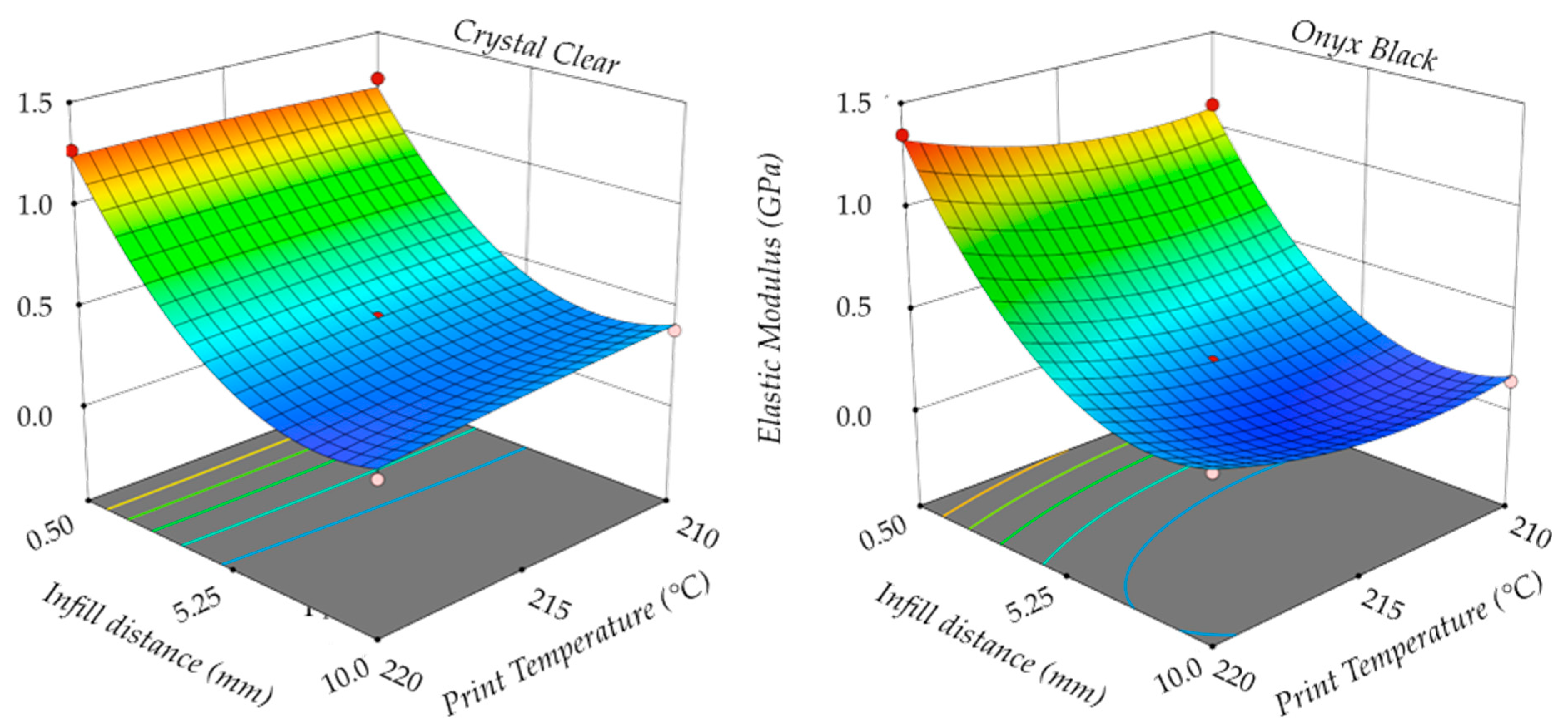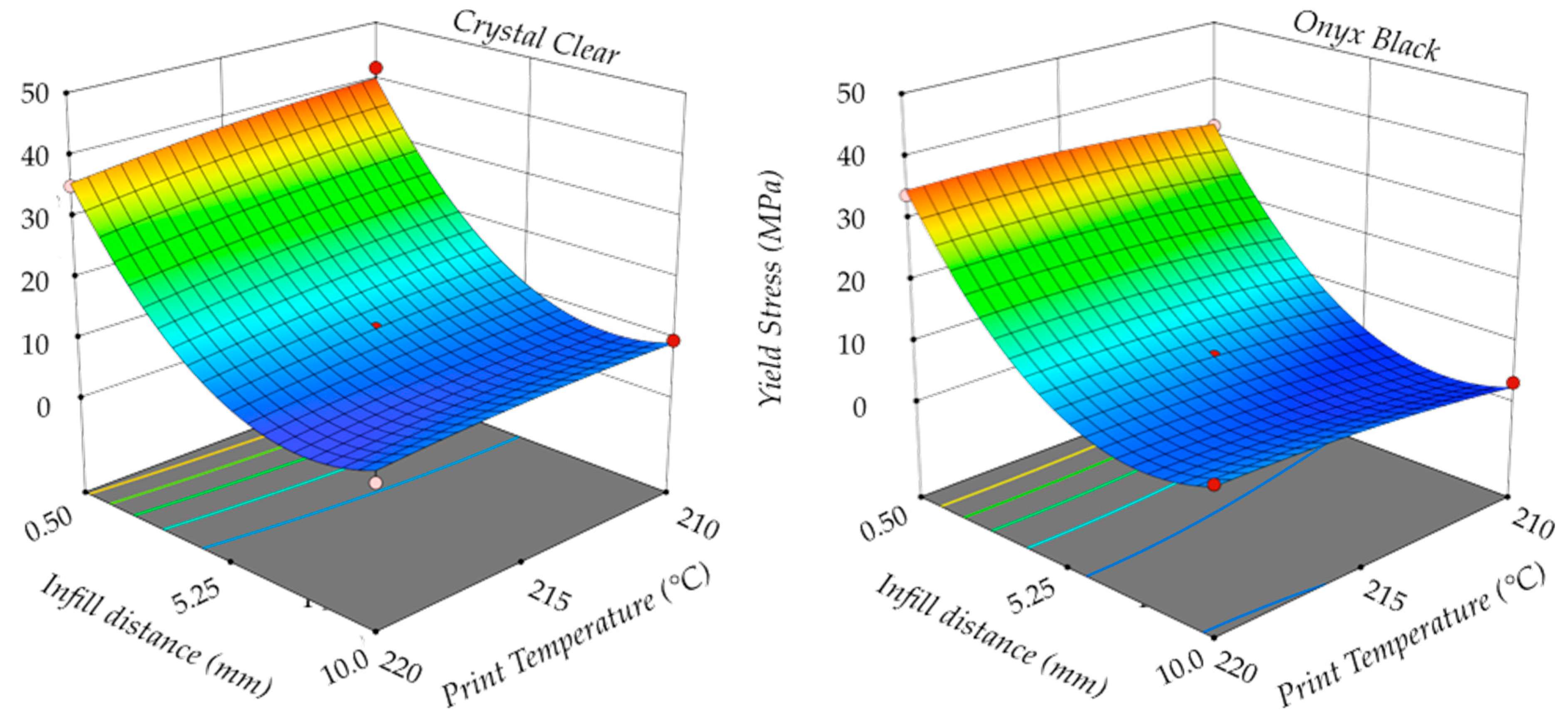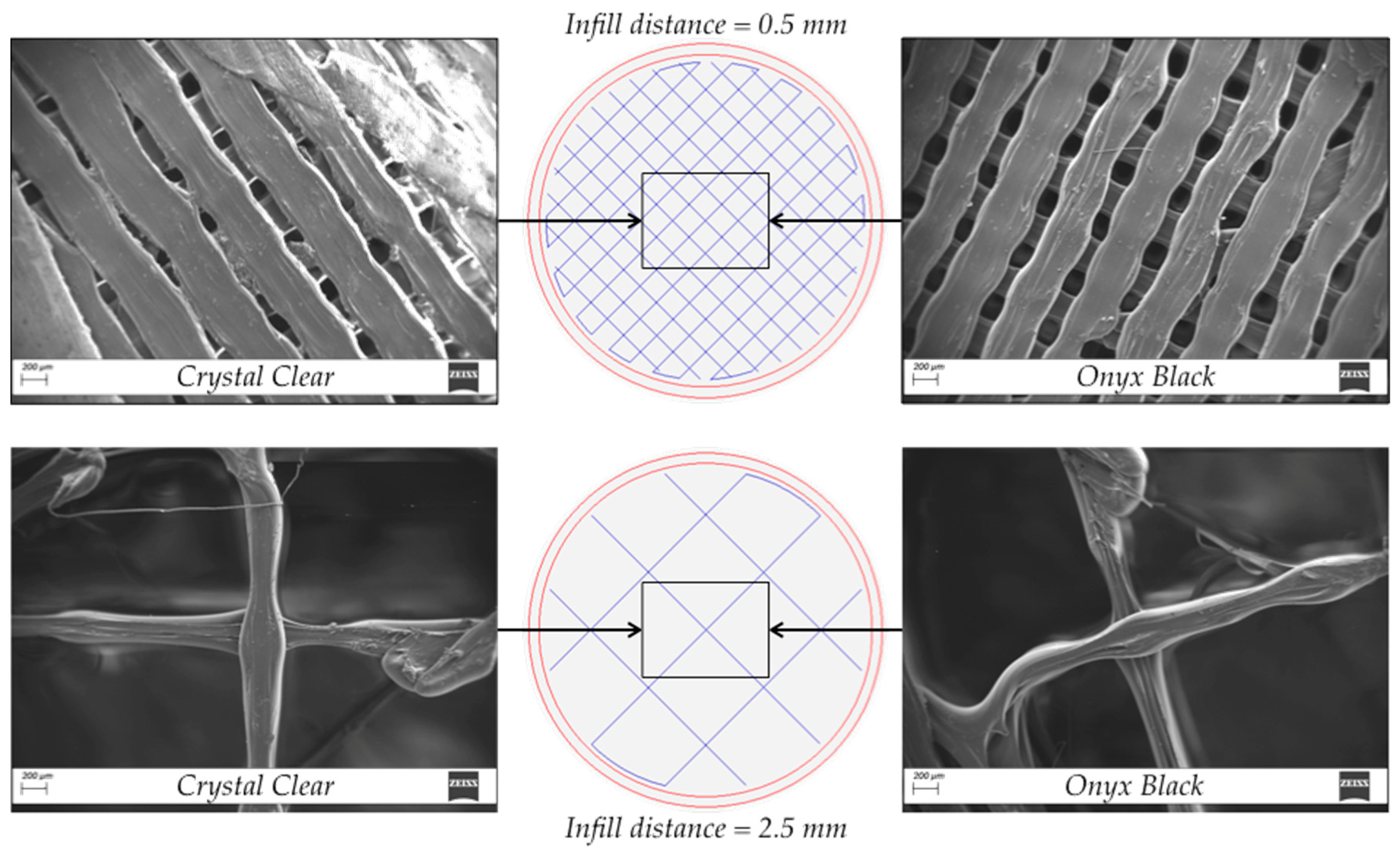The investigated PLA filaments were 1.75 mm in diameter with a dimensional diameter tolerance of ±25 μm. The main physical and mechanical properties, collected from material data sheets (M3D LLC, Fulton, MO, USA), are reported in
Table 1.
A small-scale deviation of the filament diameter value is acceptable for stable results, while a high variation is one of the primary sources of excessive changes in strength and elongation. Several measurements were repeated in different sections using a precision diameter gage to take into consideration the difference in diameter, confirming that the declared diameter tolerance was respected. The products were realized using two different PLAs, named Onyx Black and Crystal Clear. Onyx Black is a black PLA, while Crystal Clear is a transparent PLA. Neither the identity nor the composition of either PLA was exactly specified. The percentage of additives and colorants/pigment ranged between 1–5% and 0–5%, respectively. The minimum values of the physical properties were specified with no information about their evolution over time, and no specifications on the influence of the different color on thermal properties.
The thermal characterization of the materials was conducted using differential scanning calorimetry (DSC) and thermogravimetric analysis (TGA) for the thermal properties, whereas rotational rheometry (RHEO) was used for the viscosity measurements.
2.1. DSC and TGA
The identification of the thermal properties was carried out with a DSC 403 F3 Pegasus (Netzsch-Gerätebau GmbH, Selb, Germany), with a Rhodium Furnace (sensor type S) and a DSC head (sensor types E). The thermal cycle, as well as the heating and cooling rates, were precisely defined, as described in Spina et al. [
13]. Briefly, there were two consecutive runs with a heating step (from 30 °C to 220 °C), a holding step (10 min) and a cooling step (from 220 to 30 °C). The polymorphic aspect of PLA was investigated by analyzing the melting process throughout heating after non-isothermal crystallization. The first heating cycle provided information on material properties related to the filament extrusion. The second cycle reproduced the material properties after printing, supposing that the residence time in the extruder was not sufficiently long to completely erase the crystal nuclei. The baseline was computed by subtracting the signals of a specimen and an empty crucible. All measurements were carried out in the non-isothermal mode with a heating and cooling rate of 7.5 °C/min, using nitrogen (50 mL/min) as the purge gas. The sample weight of the examined material in a closed aluminum pan was approximately 8 mg. The procedure was applied using both Onyx Black and Crystal Clear filaments. Ten specimens for each material were analyzed. The results of the DSC analysis were the identification of the primary thermal properties such as the glass transition, crystallization, and melting temperatures as well as the whole temperature history, according to ISO 11357:2018 [
14], as reported in
Figure 1 and
Figure 2. The average thermogram results are reported in
Table 2, with a temperature variation of ±0.4 °C and a heat of fusion/crystallization variation of ±5 kJ/mole.
In the first heating step, Crystal Clear was characterized by a glass transition temperature of 64.5 °C, a cold crystallization temperature of 127.2 °C and a melting temperature of 153.8 °C. The cold crystallization and melt temperatures of Onyx Black were higher, equal to 155.9 and 172.7 °C, respectively, while no difference was recorded for the glass transition temperature, equal to 64.5 °C. An additional cold crystallization temperature was detected for the Onyx Black at 91.8 °C, probably because of the presence of α and α′ crystal form of PLA (Refaa et al. [
15]). The heat of fusion, equal to 183.9 and 796 kJ/mole respectively for Crystal Clear and Onyx Black, revealed a higher heat of crystallization of Onyx Black. The heat of fusion was computed as the area under the DSC signal, expressed in kJ/g, divided by the average PLA molar mass equal to 170 g/mol. The cooling step showed that the crystallization temperature of the Onyx Black was higher (126.5 °C) than that of the Crystal Clear (96.0 °C), with a very significant variation in the heat of crystallization. The crystallization of both materials was complete, and the cold crystallization effect was no longer identified in the second heating cycle. The differences in heat melting peaks continued to remain. No degradation effect occurred in either PLA, despite the different values of the heat of fusion and small reductions in the peak temperatures. The results clearly show that crystallinity was color-dependent, confirming the results of previous research (Wittbrodt and Pearce [
16]).
A Pyris 6 TGA (PerkinElmer, Waltham MA, USA) was used for the investigation in the temperature range between 30 and 800 °C. The thermal cycle consisted of a single run with a heating step from 30 to 800 °C. All measurements were carried out with a heating rate of 10 °C/min using a nitrogen atmosphere with a purge rate of 40 mL/min. The sample weight of the examined material in an open alumina crucible was approximately 60 mg. The procedure was applied to both Onyx Black and Crystal Clear filaments. The thermogravimetric curves shown in
Figure 3 are the average values of five repetitions for each material. These curves show a single-stage degradation mechanism for both materials. The samples were fully degraded at 450 °C, with a stable residue of the same magnitude up to 800 °C. These results confirmed the presence of mineral fillers (Cicala et al. [
17]).
The temperature at 5% mass loss was very similar, respectively, equal to 336.81 and 336.96 °C for Crystal Clear and Onyx Black PLA. The residue contents at 600 °C were 0.68% and 1.20% for Crystal Clear and Onyx Black PLA, respectively.
2.2. Rheological Measurements
The viscosity at different temperatures was measured with a HAAKE MARS III rotational rheometer (Thermo Fisher Scientific Inc, Waltham, MA, USA). The shielding gas was nitrogen to avoid polymer degradation, and the cooling media was water. The specimen was placed between the two highly polished stainless-steel plates of the shearing device at room temperature, heated to the investigated temperature, and held until it was completely melted. A 25.0 mm diameter disk was realized by slowly lowering the two plates to 0.5 mm. This gap was kept constant during the thermal cycle. Each variation caused by thermal expansion was compensated by automatically moving the upper plate. After melt homogenization, shear was promptly applied. The contact between the polymer and the upper plate was continuously maintained. A two-step experimental protocol was applied. Amplitude sweep tests were performed in the first step to identify a stable linear viscoelastic region of the material. The polymer viscosity was measured with frequency sweep tests during the second step. The frequency sweep tests were carried out with a shear value equal to 5 × 10
−3 because a stable common linear region was identified for shear values between 10
−3 and 10
−2. A frequency sweep is a particularly useful test to determine the viscoelastic properties of a material over time. Cox and Merz [
18] identified a strict equivalence between the complex viscosity η*(Ω) measured in an oscillatory frequency sweep and the steady shear viscosity η(dγ/d
t) measured as a function of shear rate dγ/d
t. Applying this equivalence, the viscosity of the polymer was then computed.
Figure 4 shows the viscosity measurements, made with a shear rate ranging between 6 × 10
−2 and 2 × 10
2 s
−1. Shear rate values lower than 6 × 10
−2 s
−1 were not used because the material degraded, as reported by Balani et al. [
19].
The viscosity variation field of the Crystal Clear was higher than that of the Onyx Black at all temperatures tested. In particular, the Newtonian plateau of the Crystal Clear ranged between 726 and 4826 Pa s in the investigated temperature interval of 170–220 °C, whereas the Newtonian plateau of Onyx Black ranged between 417 and 3921 Pa s. The differences in the viscosity values became smaller with increasing shear rate. In general, the high filament viscosity led to under-extrusion (impossibility to supply the right amount of material), causing missing layers, thin layers, or layers with random dots and holes. For this reason, a low viscosity is highly desirable, thus avoiding shallow values, causing over-extrusion (excess of deposited material).
The next step was the analysis of the linear viscoelastic
G′ (loss) and
G′′ (storage) moduli.
Figure 5 and
Figure 6 show the experimental measurements of both materials at shear rates ranging between 6 × 10
−2 and 2 × 10
2 s
−1.
Typical Maxwellian behavior was observed for both PLAs, independent of the presence of the colorant, in which the viscous nature was dominant at low frequencies (
G′′ >
G′), and the elastic behavior was dominant at high frequencies (
G′′ <
G′). The crossover frequency was computed to determine the characteristic relaxation time by taking the inverse of the crossover frequency.
Figure 7 contains the crossover frequencies of both PLAs as a function of the temperature. The measured crossover frequency was approximately 5–80 s
−1, corresponding to a characteristic relaxation time of 0.0125–0.2 s.
The crossover frequency of Onyx Back was higher than that of Crystal Clear. As a consequence, the lower viscosity and elasticity of Crystal Clear resulted in a much higher propensity to flow/drip soon after the filament deposition compared with Onyx Black. This behavior had been previously recorded in similar experiments (Cicala at al. [
17]).
Another important material parameter to evaluate was the molecular weight distribution (MWD). Gel permeation chromatography (GPC) is the conventional method to determine the MWD of a polymer (Van Dijk et al. [
20]). However, GPC has some disadvantages such as the polymer to be measured must be dissolved in a solvent first, the instrumentation is expensive, the measurement is a time-consuming procedure and, the method is less sensitive for high molecular components. Evaluating the MWD from rheological data is an interesting alternative to GPC by correlating the MWD with the material functions. Inherent in the rheological data is information on the sample modulus and relaxation times, which are significantly affected by molecular entanglements and the molecular weights. The procedure started with the construction of the master curves of the two PLAs and the computation of the relaxation spectra from oscillation frequency sweep data. The MWD was then computed using these data (Shawn and Tuminello [
21]).
Figure 8 shows the MWD results of the two polymers, pointing out that the difference was very small.
This result pointed out that the colorant additive affected the PLA crystallization, without changing the distribution of the molecular weight. The polydispersity was 1.075 for both PLA polymers.
The analysis of these experimental results revealed that the color additive significantly influenced the thermal and rheological properties of the filaments. According to the above results, a critical analysis of the printing parameters should be performed to optimize the mechanical response of the FFF parts.

